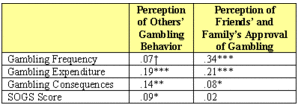The WAGER Vol. 9(7) – Attribution, Addiction, and Gambling: To Do or Not to Do What We Believe Others Do?
Series Special Editor: Sarah E. Nelson
It is a fact of life that people make some decisions based on personal perceptions of “normal” social behavior. If a person believes that his peers endorse the South Beach Diet (Agatston, 2003), he might think that the diet is the key to weight loss success. Consequently, that person might be more likely to hop on the dieting bandwagon. Some researchers believe that the same principle applies to gambling behavior—that is, a person who believes that most people consider gambling socially acceptable might be more likely to engage in higher levels of gambling activity. This week, continuing our Attribution, Addiction, and Gambling series, the WAGER reviews a recent study by Larimer and Neighbors (2003), which investigated whether perceived descriptive norms (i.e., perceptions of other students’ gambling habits) and perceived injunctive norms (i.e., perceptions about the extent to which friends and family approve of gambling) are related to students’ gambling behaviors.
The authors recruited 560 volunteer subjects (347 female) from the undergraduate psychology department at a large west-coast university. Participants averaged 19.23 (SD = 1.78) years of age, and 59.4% were Caucasian, 33.8% were Asian/Pacific Islander and 6.8% were of other races. Students who gambled at least once in their life were eligible to participate. All participants completed the Gambling Quantity and Perceived Norms Scale (Neighbors, Lostutter, Larimer, & Takushi, 2001), the South Oaks Gambling Screen (SOGS, Lesieur & Blume, 1987) and another instrument designed to measure injunctive norms associated with gambling (Moore & Ohtsuka, 1999).
Sample medians, shown in Table 1, reveal that students believe their peers gambled more than they actually reported. This observation provides evidence for a false consensus effect (i.e., the belief that others share one’s beliefs and engage in certain activities to a similar or greater extent than oneself) surrounding gambling behaviors.
Table 1. Median Perceived v. Reported Behaviors* (Larimer & Neighbors, 2003)
* All differences significant at p<.0001 using the Wilcoxon signed rank test
The authors also found significant correlations between participants’ perceptions of others’ behavior and approval and their own gambling behavior (see Table 2). For example, subjects that perceived gambling as more prevalent among peers (i.e., inflated perceived descriptive norms) evidenced above average personal gambling expenditures and frequency, increased negative gambling consequences and higher SOGS scores. Subjects who overestimated others’ approval of gambling (i.e., inflated perceived injunctive norms) also experienced higher gambling involvement (i.e., expenditure and frequency) and slightly higher gambling consequences, but did not show increased SOGS scores. Perceived injunctive norms and perceived descriptive norms did not correlate with each other.
Table 2. Correlations Among Social Norms and Gambling Outcomes (adapted from Larimer & Neighbors, 2003)
*** p<.001. ** p<.01. * p<.05. † p<.10.
Taken together, these findings highlight the impact of beliefs and perceptions on individuals’ gambling behaviors; however, there are several methodological limitations to this study. All subjects who participated in this study were students; therefore, the results might not be representative of the wider population. Further, this study utilized a cross-sectional design (i.e., collected data at a single point in time, rather than over time); it is possible that individuals’ perceptions of gambling acceptability and others’ gambling behavior vary over time with changes in wider public opinion regarding gambling or that the causal sequence is the reverse of that presented here (i.e., perceptions may vary as a function of subjects’ gambling behavior). Finally, although perceptions related to gambling behavior, they were only weakly correlated with gambling consequences and SOGS scores. This finding calls into question the utility of using perceived norms to identify students at high risk for developing gambling problems.
Nevertheless, this research underscores potentially valuable information about how social perceptions can influence gambling behavior. Attributions about how often others gamble influence how often the observer will gamble – even if these perceptions are not accurate. Although these perceived norms may not help to identify gambling disorders, we can hypothesize that if students were more aware of the actual gambling behaviors of their peers, they might be less inclined to begin or continue gambling at levels associated with their inflated perceptions. This hypothesis suggests a need for targeted gambling education – intervention tools that inform at-risk gambling populations about the differences between perceived and actual gambling behavior. However, this kind of social norms method has proven unreliable for reducing risky alcohol behaviors (e.g., Wechsler et al., 2003), indicating that our understanding of the relationship between norms and behavior might not be complete. More research on how people’s expectations and perceptions change across time as their behavior changes is needed to understand more fully how norms influence behavior and target interventions accordingly.
So, is society really slimming down by following the South Beach Diet? Before you give up those carbs, maybe it’s worth a second look.
Comments on this article can be addressed to Tony Donato.
References
Agatston, A. (2003). The South Beach Diet. New York: Rodale Press.
Larimer, M. E., & Neighbors, C. (2003). Normative misperception and the impact of descriptive and injunctive norms on college student gambling. Psychology of Addictive Behaviors, 17(3), 235-243.
Lesieur, H. R., & Blume, S. B. (1987). The South Oaks Gambling Screen (SOGS): A new instrument for the identification of pathological gamblers. American Journal of Psychiatry, 144(9), 1184-1188.
Moore, S. M., & Ohtsuka, K. (1999). The prediction of gambling behavior and problem gambling from attitudes and perceived norms. Social Behavior and Personality, 27, 455-466.
Neighbors, C., Lostutter, T. W., Larimer, M. E., & Takushi, R. Y. (2001). Measuring gambling outcomes among college students. Journal of Gambling Studies, 18, 339-360.
Wechsler, H., Nelson, T. E., Lee, J. E., Seibring, M., Lewis, C., & Keeling, R. P. (2003). Perception and reality: a national evaluation of social norms marketing interventions to reduce college students’ heavy alcohol use. Journal of Studies on Alcohol, 64(4), 484-494.

